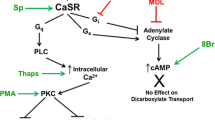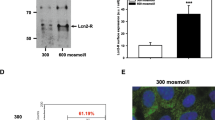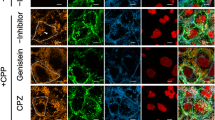Abstract
Suspensions of LLC-PK1 cells were used to determine the effect of bile acids on the cellular homeostasis of morganic ions. It is determined that bile acids alter cellular free calcium (Cai) levels in LLC-PK1 cells. A series of bile acids were compared and found to produce increases in Cai in the order: lithocholate sulfate (LCS) > deoxycholate > chenodeoxycholate > lithocholate glucuronide > cholate. LCS (300 μM) produces changes in Cai (measured using Fura-2) qualitatively similar to those produced by 1 μM monomycin, except that only ionomycin is able to release calcium from intracellular stores. The effect on Cai is roughly proportional to LCS concentration between 50 and 300 μM. The presence of 40 mM Na in the extracellular medium reduces the LCS-induced rise in Cai to 20% of that observed in the absence of Na. This effect is specific for Na versus 150 mM extracellular K, Li, or TMA. The effect is not dependent on the Na gradient across the membrane. At concentrations of LCS which induce changes in Cai, no significant effect of LCS is observed on either cellular Na or K levels, or intracellular pH.
Similar content being viewed by others
Abbreviations
- BCECF:
-
2,7′-bis-(2-carboxyethyl)-5,6-carboxy-fluorescein
- HEPES:
-
4-(-2-hydroxyethyl)-1-piperazine ethanesulfonate
- TMA:
-
tetramethylammonium
- PCA:
-
perchloric acid
- LCS:
-
lithocholate sulfate
- EGTA:
-
ethylene glycol-bis-(β-aminoethyl ether)N,N″-tetra-acetic acid
- Cai :
-
intracellular free calcium
- pH:
-
intracellular pH
References
Abramson JJ, Shamoo AE (1979) Anionic detergents as divalent cation ionophores across black lipid membranes. J Membr Biol 50:241–244
Ammon H, Dharmsathaphorn K (1986) Mechanism of action of bile salts on colonic Cl-secretion: a study based on a cultured epithelial model. Clin Res 34:436A (abstract)
Anwer MS, Engelking LR, Zimniak P, Leser R (1986) Taurolithocholate (TLC) but not taurocholate (TC) increases cytosolic Ca++ activity in isolated rat hepatocytes. Hepatology 6:1214 (abstract)
Aoyagi T, Lowenstein LM (1968) The effect of bile acids and renal ischemia on renal function. J Lab Clin Med 71:686–692
Baum M, Stirling GA, Dawson JL (1969) Further study into obstructive jaundice and ischaemic renal damage. Br Med J 2:229–231
Binder HJ, Filburn C, Volpe BT (1975) Bile salt alteration of colonic electrolyte transport: Role of cyclic adenosine monophosphate. Gastroenterology 68:503–508
Bonventre JV, Cheung JY (1986) Cytosolic free calcium concentration in cultured renal epithelial cells. Am J Physiol 250: F329-F338
Gmaj P, Murer H, Carafoli E (1982) Localization and properties of a high-affinity (Ca2++Mg2+)-ATPase in isolated kidney cortex plasma membranes. FEBS Lett 144:226–230
Grynkiewicz G, Poenic M, Tsien RY (1985) A new generation of Ca2+ indicators with greatly improved fluorescence properties. J Biol Chem 260:3440–3450
Hull RN, Cherry WR, Weaver GW (1976) The origin and characteristics of a pig kidney cell strain, LLC-PK1. In Vitro 12:670–677
Kakis G, Yousef IM (1978) Pathogenesis of lithocholate and taurolithocholate induced intrahepatic cholestasis in rats. Gastroenterology 75:595–607
Maenz DD, Forsyth GW (1982) Ricinoleate and deoxycholate are calcium ionophores in jejunal brush border vesicles. J Membr Biol 70:125–133
Montrose MH, Murer H (1986) Regulation of intracellular pH in LLC-PK1 cells by Na+/H+ exchange. J Membr Biol 93:33–42
Oelberg DG, Lester R (1986) Cellular mechanisms of cholestasis. Clin Rev Med 372:297–317
Oelberg DG, Dubinsky WP, Adcock EW, Lester R (1984) Calcium binding by lithocholic acid derivatives. Am J Physiol 247:G112-G115
Oelberg DG, Sackman JW, Dubinsky SP, Adcock EW, Lester R (1984) Mechanism of bile salt-induced hemolysis. Gastroenterology 86:1198 (abstract)
Oelberg DG, Sackman JW, Adcock EW, Lester R, Dubinsky WP (1985) Bile salts function as calcium ionophores. Pediatr Res 5:1005 (abstract)
Palmer RH (1984) Hemolytic effects of steroids. Nature 201:1134–1135
Palmer RH (1972) Bile acids, liver injury and liver disease. Arch Intern Med 130:606–617
Priestly BG, Cote MG, Plaa GL (1971) Biochemical and morphological parameters of taurolithocholate-induced cholestasis. Can J Physiol Pharmacol 49:1078–1091
Rahban S, Bonorris GG, Marks JW, Chung A, Schoenfield LJ (1980) The effect of dihydroxy bile acids on intestinal secretion, cyclic nucleotides and Na+-K+ ATPase. Am J Med Sci 279:141–146
Rasmussen H (1986) The calcium and the mechanisms of liver necrosis (first of two parts). N Engl J Med 314:1094–1101
Scharschmidt BF (1983) Jaundice. In: Gastrointest disease, 3rd ed. Saunders, Philadelphia, pp 355–368
Scharschmidt BF, Keeffe EB, Vessey DA, Blankenship NM, Ockner RK (1981) In vitro effect of bile salts on rat liver plasma membrane lipid fluidity and ATPase activity. Hepatology 1:137–145
Takikawa H, Otsuka H, Beppu T, Seyama Y, Yamakawa T (1983) Serum concentrations of bile acide glucuronides in hepatobiliary diseases. Digestion 27:189–195
Takikawa H, Beppu T, Seyama Y, Sugimoto T (1986) Glucuronidated and sulfated bile acids in serum of patients with acute hepatitis. Dig Dis Sci 31:487–491
Talalay P (1964) Enzymic analysis of steroid hormones. Methods Biochem Anal 8:119–143
Williams RJP (1970) The biochemistry of sodium, potassium, magnesium, and calcium. Q Rev Chem Soc 24:331–365
Williamson BWA, Percy-Robb IW (1979) The interaction of calcium ions with glycocholate micelles in aqueous solution. Biochem J 181:61–66
Youself IM, Tuchweber B, Vonk RJ, Masse D, Audet M, Roy CC (1981) Lithocholate cholestasis-sulfated glycolithocholate-induced intrahepatic cholestasis in rats. Gastroenterology 80:233–241
Zimniak P, Oelberg DG, Lester R (1985) Bile salts as Ca ionophores in Ca-ATPase containing liposomes. Hepatology 5:1005 (abstract)
Author information
Authors and Affiliations
Rights and permissions
About this article
Cite this article
Montrose, M.H., Lester, R., Zimniak, P. et al. Bile acids increase cellular free calcium in cultured kidney cells (LLC-PK1). Pflugers Arch. 412, 164–171 (1988). https://doi.org/10.1007/BF00583746
Received:
Revised:
Accepted:
Issue Date:
DOI: https://doi.org/10.1007/BF00583746




